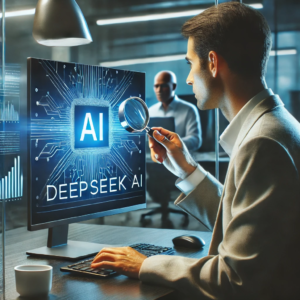I Quit AI for 7 Days – Here’s How It Affected My Work
Stepping away from artificial intelligence tools felt like disconnecting from a vital organ in my professional body. As someone deeply embedded in the digital workspace, I went from using AI daily to quitting cold turkey. The decision to embark on this seven-day experiment came from a growing unease about my increasing dependence on AI tools for everything from email composition to strategic planning. What started as a curiosity-driven experiment transformed into a profound journey of professional self-discovery and technological mindfulness. The results were both challenging and enlightening, revealing insights that would forever change my approach to work and technology.
We strongly recommend that you check out our guide on how to take advantage of AI in today’s passive income economy.
Table of Contents
The Decision to Disconnect
The morning started like any other – multiple browser tabs open, AI chatbots ready to assist, and automated tools humming in the background. But something felt off. The constant reliance on AI had created a subtle disconnect between me and my creative process. This realization struck me during a crucial client presentation when I noticed that my responses, though efficient, lacked the personal touch and emotional intelligence that once defined my professional interactions. The automated efficiency had slowly eroded the human element in my work, leading to a kind of professional autopilot that, while productive, felt increasingly hollow. This awakening prompted me to take a bold step: completely disconnecting from AI tools for an entire week. The decision wasn’t just about proving a point; it was about rediscovering my professional identity in an AI-dominated landscape.
The First 48 Hours: Withdrawal Symptoms
The initial shock hit harder than expected. Simple tasks that AI handled effortlessly now required manual attention, revealing just how deeply artificial intelligence had embedded itself into my daily workflow. The first morning alone was a struggle – crafting emails took three times longer, scheduling meetings became a manual puzzle, and content creation felt like trying to run through quicksand. The muscle memory of reaching for AI assistance needed constant suppression, and each time I caught myself about to use an AI tool, it highlighted just how automatic these behaviors had become. The experience was similar to trying to write with your non-dominant hand – everything felt clumsy, slower, and required intense concentration. This period of adjustment revealed the extent of my AI dependence and forced me to confront the reality of how much I had delegated my thinking to automated systems.
Rediscovering Human Intelligence
By day three, something remarkable began to emerge from the fog of AI withdrawal. The initial frustration gave way to a rediscovery of dormant skills and capabilities. Without AI’s constant suggestions and automated responses, my brain began to flex muscles that had grown weak from disuse. Problem-solving became more intuitive as I was forced to rely on my own knowledge and experience rather than defaulting to AI-generated solutions. This period marked the beginning of a profound transformation in how I approached work tasks. The creative process, though slower, felt more authentic and satisfying. Client interactions, while requiring more preparation, became richer and more nuanced. This phase revealed that while AI had made my work more efficient, it had also inadvertently placed a filter between me and my natural problem-solving abilities.
The Midweek Revelation
The fourth day brought an epiphany about the role of AI in modern work life that would fundamentally change my perspective on technology integration. While artificial intelligence tools significantly boost productivity, they shouldn’t replace human judgment and creativity. This revelation came during a particularly challenging project where I had to develop a comprehensive marketing strategy. Without AI’s rapid analysis and suggestions, I was forced to deeply engage with the project’s nuances, leading to insights that might have been overlooked by algorithmic analysis. The human capacity for nuanced understanding, emotional intelligence, and creative problem-solving began to shine through, demonstrating that some aspects of professional work simply cannot be automated or enhanced by AI without losing something essential in the process.
The Transformation
As the week progressed, a new workflow emerged that would reshape my entire approach to professional tasks. The initial struggle gave way to a more balanced and thoughtful work process. Tasks that previously relied heavily on AI assistance were now approached with a combination of human insight and manual effort. This transformation wasn’t just about working without AI; it was about rediscovering the value of human intelligence and creativity in the modern workplace. The experience revealed that many tasks I had automated could benefit from a more hands-on approach, leading to better quality outcomes and more satisfying professional experiences. This period of transformation also highlighted the importance of maintaining and developing core professional skills, regardless of technological advancement.
The Professional Impact
The most significant change manifested in decision-making processes and creative work. Without AI’s rapid suggestions, each choice required deeper consideration, leading to more thoughtful and nuanced outcomes. Client presentations became more personalized, drawing from genuine human experience rather than AI-generated frameworks. Strategic planning incorporated more human-centric approaches, considering emotional and contextual factors that AI might overlook. The impact on work quality was noticeable – while some tasks took longer to complete, the results showed greater depth and originality. This phase demonstrated that while AI can enhance efficiency, it shouldn’t come at the cost of authentic human input and creativity.
The Social Dimension
Team dynamics shifted noticeably during this experiment, revealing unexpected benefits of reducing AI dependency. Conversations became richer and more authentic, as team members engaged in genuine dialogue rather than relying on AI-generated talking points. Brainstorming sessions evolved into more dynamic exchanges of ideas, with each participant contributing unique perspectives shaped by personal experience rather than algorithmic suggestions. The absence of AI-generated solutions fostered greater team engagement and creative discussion, leading to more innovative and collaborative problem-solving approaches. This period highlighted the irreplaceable value of human interaction and collective creativity in professional settings.
The Learning Curve
Every day brought new insights about work efficiency and creativity that challenged preconceptions about productivity and success. Tasks that seemed impossible without AI became manageable through alternative approaches, often yielding better results. The learning process wasn’t just about finding ways to work without AI; it was about understanding the true value of human capabilities in professional contexts. This period of adjustment revealed that many skills had been unnecessarily delegated to AI, leading to a diminishment of human expertise and judgment. The experience highlighted the importance of maintaining core professional skills independent of technological assistance, ensuring resilience and adaptability in an ever-changing work environment.
The Return to AI
The reintegration of AI tools after seven days marked not just an end to the experiment, but the beginning of a new, more balanced approach to technology use. Instead of defaulting to AI for every task, a more thoughtful and selective process emerged. The experience created a framework for mindful AI utilization, where technology enhances rather than replaces human capabilities. This new approach led to more effective use of AI tools, with clear boundaries between tasks that benefit from automation and those that require human touch. The reintegration phase demonstrated that the most effective work strategy combines the efficiency of AI with the irreplaceable qualities of human intelligence.
The New Normal
The post-experiment phase revealed a more sustainable and effective relationship with AI, fundamentally changing how technology integrated into daily work life. Understanding when to leverage AI and when to rely on human skills became clearer, leading to improved work quality and greater job satisfaction. This new normal wasn’t about rejecting AI but about using it more intentionally and effectively. The experience showed that the best results come from a thoughtful combination of human and artificial intelligence, each deployed where they can provide the most value.
Key Takeaways
The seven-day AI break reshaped perspectives on technology’s role in modern work life in ways that continue to influence daily professional practices. It demonstrated the importance of maintaining human skills while embracing technological advancement, creating a more balanced and effective approach to work. The experience provided valuable insights into creating a work environment that maximizes both human potential and technological capabilities. This period of reflection and adaptation led to a deeper understanding of how to integrate AI tools effectively while preserving the essential human elements of professional work.
The Future Approach
Moving forward, the integration of AI tools became more strategic and purposeful, fundamentally changing the approach to professional development and technological utilization. The focus shifted to using AI as an enhancement rather than a replacement for human capabilities, leading to better outcomes and more meaningful professional growth. This new approach emphasizes the importance of maintaining a balance between technological efficiency and human creativity, ensuring that neither is sacrificed for the other. The experience created a framework for future technology adoption that prioritizes human agency while maximizing the benefits of artificial intelligence.
Conclusion
The week without AI transformed more than just work processes – it fundamentally changed the entire approach to professional development and technological dependence. The experience proved that while AI is a powerful tool, the human element remains irreplaceable in the modern workplace. This journey from complete AI dependence to thoughtful integration created a blueprint for others seeking to optimize their relationship with technology. The key lies not in avoiding AI but in understanding its proper place in our professional lives, ensuring that it enhances rather than replaces human capabilities. This experiment revealed that the future of work isn’t about choosing between human and artificial intelligence, but about finding the perfect balance between both.

We strongly recommend that you check out our guide on how to take advantage of AI in today’s passive income economy.




